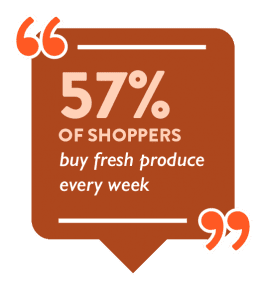As a mom of two growing boys, I’m not surprised shoppers with children had a higher likelihood of buying fruits and vegetables more than once a week. It’s in our nature to be doing more fill-in trips, especially as the kids get bigger, hungrier, and – oddly – pickier.


When it comes to frequency of fresh produce purchase, shoppers typically buy weekly or a few times a month, according to the Shopper Insights 2020: Consumer Trends, Shopping Behaviors and Marketing Opportunities. Moxxy Marketing BB #:341508 commissioned the study, a survey of 2,000 American produce consumers conducted in August and analyzed by Category Partners.
While they seem to be divergent retail styles, shoppers who frequent natural and specialty foods stores and discount grocers skewed much higher than average on weekly shops, 65% vs 57% overall.
Income also was a factor in frequency of shopping. The lowest income bracket on the survey – $30,000 to $49,999 was more likely to shop a few times a month, while the highest bracket had a stronger affinity for picking up produce more than once a week.
Analyzing purchase frequency demographics can help hone messaging to improve sales.


Demographics also differ in a few key areas when it comes to retailer preference.
While 83 percent of shoppers said they buy their groceries at Supermarkets, the youngest age group, 25-34, also was fond of other outlets like Walmart, Natural/Specialty Stores, Online, Discount and Dollar Stores.
Shoppers in the Northeast also were much less likely to shop at Walmart, with only 37% naming the superstore a typical place to purchase groceries. Sixty-one percent of shoppers in the South, however, reported they shopped for groceries at Walmart.
Income, not surprisingly, fell along predictable lines when comparing affinity for Warehouse/Club stores and Natural/Specialty Stores. While 45% of shoppers on average said they bought groceries at Warehouse/Clubs, only 33% of those in the lowest income bracket shopped there, compared with 55 percent of those in the highest income bracket, earning $150,000 or more a year.

Younger age groups, ages 25 to 44, were the most likely to try alternatives to supermarkets. Online shopping, especially, had a larger gap in preference among younger groups. About 24 percent of the younger groups said they buy groceries online compared to 7 percent in the oldest age group and 10 percent in ages 55 to 64.
“These demographic insights illustrate why marketers are so focused on understanding Gen Z and Millennial shoppers,” Nardozza explained. “Their purchasing behaviors are different from the traditional shopping patterns of the older generations, and as their purchasing power grows, it’s important to understand them to be able to shift produce marketing strategies to leverage their preferences. They might not shop where you think they do – as these shopping behaviors change, marketing strategies to reach these consumers must make adjustments as well.”



